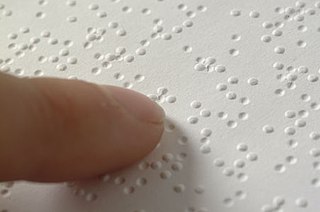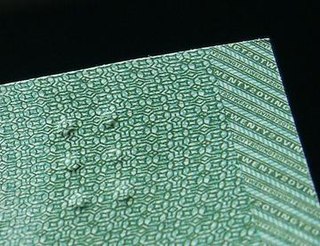
Braille is a tactile writing system used by people who are visually impaired, including people who suffer from low vision, blindness, or deafblindness. It can be read either on embossed paper or by using refreshable braille displays that connect to computers and smartphone devices. Braille can be written using a slate and stylus, a braille writer, an electronic braille notetaker or with the use of a computer connected to a braille embosser.

The dot-com bubble was a stock market bubble in the late 1990s. The period coincided with massive growth in Internet adoption, a proliferation of available venture capital, and the rapid growth of valuations in new dot-com startups.
The ellipsis... is a series of dots that indicates an intentional omission of a word, sentence, or whole section from a text without altering its original meaning. The plural is ellipses. The term originates from the Ancient Greek: ἔλλειψις, élleipsis meaning 'leave out'.

The Maya numeral system was the system to represent numbers and calendar dates in the Maya civilization. It was a vigesimal (base-20) positional numeral system. The numerals are made up of three symbols: zero, one and five. For example, thirteen is written as three dots in a horizontal row above two horizontal bars; sometimes it is also written as three vertical dots to the left of two vertical bars. With these three symbols, each of the twenty vigesimal digits could be written.

In celestial mechanics, an orbit is the curved trajectory of an object such as the trajectory of a planet around a star, or of a natural satellite around a planet, or of an artificial satellite around an object or position in space such as a planet, moon, asteroid, or Lagrange point. Normally, orbit refers to a regularly repeating trajectory, although it may also refer to a non-repeating trajectory. To a close approximation, planets and satellites follow elliptic orbits, with the center of mass being orbited at a focal point of the ellipse, as described by Kepler's laws of planetary motion.

In physics, angular velocity, also known as angular frequency vector, is a pseudovector representation of how the angular position or orientation of an object changes with time, i.e. how quickly an object rotates around an axis of rotation and how fast the axis itself changes direction.

A decimal separator is a symbol used to separate the integer part from the fractional part of a number written in decimal form. Different countries officially designate different symbols for use as the separator. The choice of symbol also affects the choice of symbol for the thousands separator used in digit grouping.
An interpunct⟨·⟩, also known as an interpoint, middle dot, middot, centered dot or centred dot, is a punctuation mark consisting of a vertically centered dot used for interword separation in Classical Latin. It appears in a variety of uses in some modern languages and is present in Unicode as U+00B7·MIDDLE DOT.
In mathematics, the dot product or scalar product is an algebraic operation that takes two equal-length sequences of numbers, and returns a single number. In Euclidean geometry, the dot product of the Cartesian coordinates of two vectors is widely used. It is often called the inner product of Euclidean space, even though it is not the only inner product that can be defined on Euclidean space.

Dot Records was an American record label founded by Randy Wood and Gene Nobles that was active between 1950 and 1978. The original headquarters of Dot Records were in Gallatin, Tennessee. In its early years, Dot specialized in artists from Tennessee. Then it branched out to include musicians from across the U.S. It recorded country music, rhythm and blues, polkas, waltzes, gospel, rockabilly, pop, and early rock and roll.

The Syriac alphabet is a writing system primarily used to write the Syriac language since the 1st century AD. It is one of the Semitic abjads descending from the Aramaic alphabet through the Palmyrene alphabet, and shares similarities with the Phoenician, Hebrew, Arabic and Sogdian, the precursor and a direct ancestor of the traditional Mongolian scripts.

In Western musical notation, a dotted note is a note with a small dot written after it. In modern practice, the first dot increases the duration of the basic note by half of its original value. This means that a dotted note is equivalent to writing the basic note tied to a note of half the value – for instance, a dotted half note is equivalent to a half note tied to a quarter note. Subsequent dots add progressively halved value, as shown in the example to the right.

New York Point is a braille-like system of tactile writing for the blind invented by William Bell Wait (1839–1916), a teacher in the New York Institute for the Education of the Blind. The system used one to four pairs of points set side by side, each containing one or two dots. The most common letters are written with the fewest points, a strategy also employed by the competing American Braille.

The Canadian currency tactile feature is a feature on the Canadian Journey and Frontier series of Canadian banknotes to aid people who are visually impaired to identify the notes. The feature indicates the banknote denomination in the upper left corner of the face side of the bill using a series of raised dots. It was suggested by Bruno Thériault, an administrator for the Canadian National Institute for the Blind, and designed by Susan Lederman, a professor of psychology at Queen's University.

Ethel May Skinner is a fictional character from the BBC soap opera EastEnders, played by Gretchen Franklin. Ethel also features in a 1988 EastEnders special episode, entitled "CivvyStreet", set on Albert Square during World War II, in which she is played by Alison Bettles.

The Nestorian Cross is associated with the Church of the East. It is composed of a cross similar to the Maltese cross, with four arms of roughly equal length which narrow in width towards the center of the cross. In Eastern Christian art in China, these crosses are sometimes simplified and depicted as resting on a lotus flower or on a stylized cloud.
The full stop, period, or full point. is a punctuation mark. It is used for several purposes, most often to mark the end of a declarative sentence. This sentence-ending use, alone, defines the strictest sense of full stop. Although full stop technically applies only when the mark is used to end a sentence, the distinction – drawn since at least 1897 – is not maintained by all modern style guides and dictionaries.
Louis Braille's original publication, Procedure for Writing Words, Music, and Plainsong in Dots (1829), credits Barbier's night writing as being the basis for the braille script. It differed in a fundamental way from modern braille: It contained nine decades (series) of characters rather than the modern five, utilizing dashes as well as dots. Braille recognized, however, that the dashes were problematic, being difficult to distinguish from the dots in practice, and those characters were abandoned in the second edition of the book.
Braille Kanji is a system of braille for transcribing written Japanese. It was devised in 1969 by Taiichi Kawakami, a teacher at the Osaka School for the Blind, and was still being revised in 1991. It supplements Japanese Braille by providing a means of directly encoding kanji characters without having to first convert them to kana. It uses an 8-dot braille cell, with the lower six dots corresponding to the cells of standard Japanese Braille, and the upper two dots indicating the constituent parts of the kanji. The upper dots are numbered 0 and 7, the opposite convention of 8-dot braille in Western countries, where the extra dots are added to the bottom of the cell. A kanji will be transcribed by anywhere from one to three braille cells.












